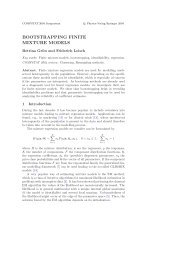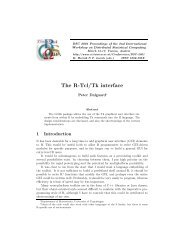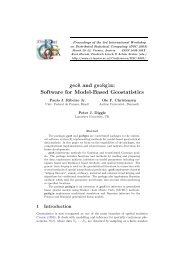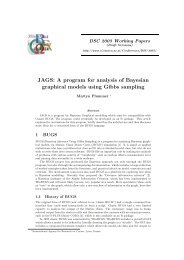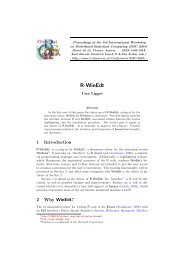Embedding R in Windows applications, and executing R remotely
Embedding R in Windows applications, and executing R remotely
Embedding R in Windows applications, and executing R remotely
You also want an ePaper? Increase the reach of your titles
YUMPU automatically turns print PDFs into web optimized ePapers that Google loves.
2.1 The foundation provided by Knoppix<br />
It is useful to reiterate some of the key po<strong>in</strong>ts of the Knoppix (Knopper, 2001) ‘live cdrom’ system:<br />
• usable on virtually any recent desktop or laptop;<br />
• available for system recovery <strong>and</strong> forensics due to a large number of <strong>in</strong>cluded utilities <strong>and</strong> tools for<br />
network <strong>and</strong> system adm<strong>in</strong>istrators;<br />
• usable <strong>in</strong> computer labs as mach<strong>in</strong>es can be rebooted quickly <strong>in</strong>to identical states;<br />
• can be used by students as no system adm<strong>in</strong>istration skills are required for setup <strong>and</strong> <strong>in</strong>stallation;<br />
• lowers barriers to entry for L<strong>in</strong>ux <strong>and</strong> Unix technology as it provides a ready-to-use system;<br />
• requires little retra<strong>in</strong><strong>in</strong>g as the KDE desktop environment provides a familiar user experience to other<br />
common operation system <strong>in</strong>terfaces;<br />
• provides a term<strong>in</strong>alserver mode allow<strong>in</strong>g other netboot-capable mach<strong>in</strong>es (potentially with hard-disk<br />
<strong>and</strong>/or cdrom) to be <strong>in</strong>itialized <strong>and</strong> booted us<strong>in</strong>g the PXE protocol (or via etherboot) <strong>in</strong> a th<strong>in</strong>-client<br />
environment;<br />
• provides a ‘persistent home’ mode where data can be written to USB storage devices (or disk partitions)<br />
to preserve states between sessions;<br />
• permits one to try L<strong>in</strong>ux risk-free as no <strong>in</strong>formation is written to the hard disk, or exist<strong>in</strong>g operat<strong>in</strong>g<br />
system;<br />
• enables to try L<strong>in</strong>ux on new hardware to reliably test its compatibility.<br />
Knoppix is under active development <strong>and</strong> released several times a year.<br />
2.2 Quantian contributions<br />
The first two Quantian releases were based directly on Knoppix. In order to add quantitatively-focused<br />
software, exist<strong>in</strong>g programs have to be removed. The list of software that is removed from the base system<br />
is determ<strong>in</strong>ed with the dual objectives of a) creat<strong>in</strong>g a maximum amount of capacity <strong>and</strong> b) remov<strong>in</strong>g<br />
<strong>applications</strong> with limited usefulness <strong>in</strong> a quantitative analysis sett<strong>in</strong>g. Consequently, we remove several<br />
large <strong>applications</strong> such as openoffice (which is also removed from the most-recent Knoppix versions), mozilla<br />
<strong>and</strong> gimp, <strong>in</strong>ternationalization packages, games, the bochs <strong>and</strong> w<strong>in</strong>e emulators, several additional w<strong>in</strong>dow<br />
managers, some network<strong>in</strong>g tools as well as a few miscellaneous <strong>applications</strong>. In total, about 500mb of<br />
software are removed.<br />
The base system stills conta<strong>in</strong>s around 1.5gb of software <strong>in</strong>clud<strong>in</strong>g a complete KDE environment with its<br />
w<strong>in</strong>dow manager, browser, office suite, development environment <strong>and</strong> editors as well as a large number of<br />
other general-purpose tools, utilities <strong>and</strong> diagnostic <strong>applications</strong>.<br />
Quantian then adds various sets of <strong>applications</strong> from different areas:<br />
mathematical such as the giac, g<strong>in</strong>ac, maxima, gap, pari <strong>and</strong> yacas computer-algebra systems, as well as<br />
the euler <strong>and</strong> xppaut <strong>applications</strong>;<br />
statistical such as the R language <strong>and</strong> environment for ‘programm<strong>in</strong>g with data’ (along with several packages<br />
from CRAN, the Emacs Speaks Statistics (or ESS) mode for Emacs <strong>and</strong> XEmacs, <strong>and</strong> the Ggobi<br />
data visualization tool) as well as autoclass, gretl, mcl, multimix, x12a <strong>and</strong> xlispstat;<br />
visualization such as the OpenDX <strong>and</strong> Mayavi visualizers, as well as gnuplot, grace, gri, xfig <strong>and</strong> plotutils<br />
for scientific plott<strong>in</strong>g;<br />
libraries such as the GNU Scientific Library (or GSL) <strong>and</strong> QuantLib, a quantitative f<strong>in</strong>ance library for risk<br />
management <strong>and</strong> trad<strong>in</strong>g;<br />
2




